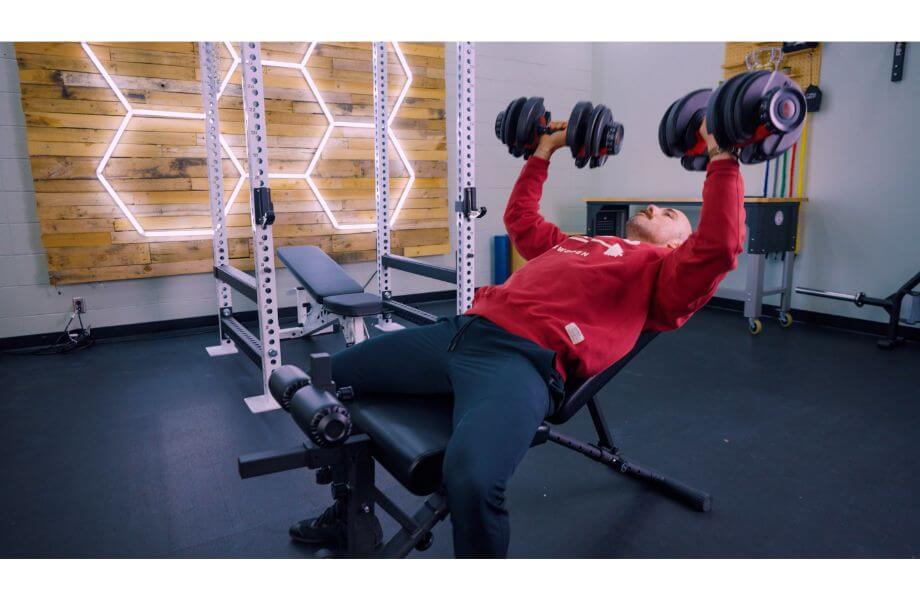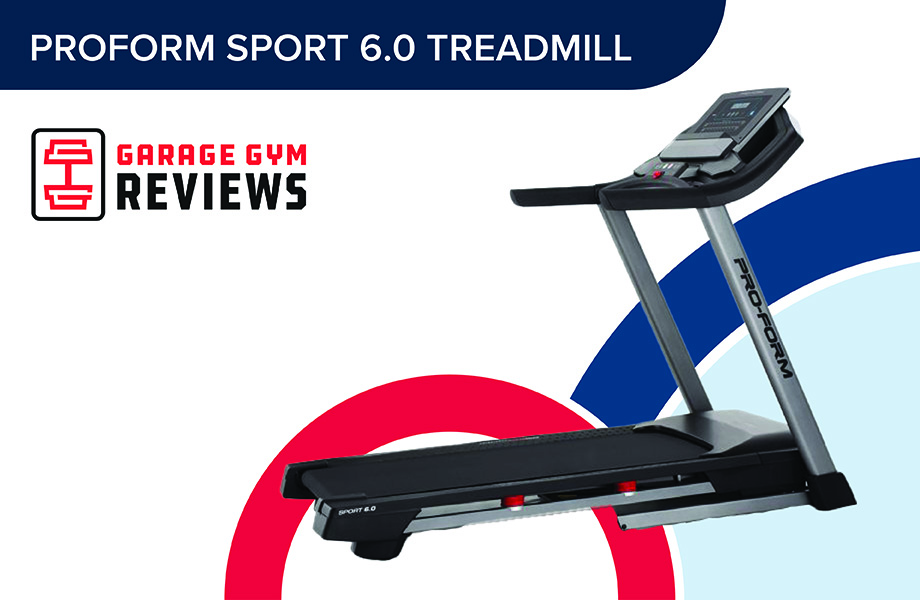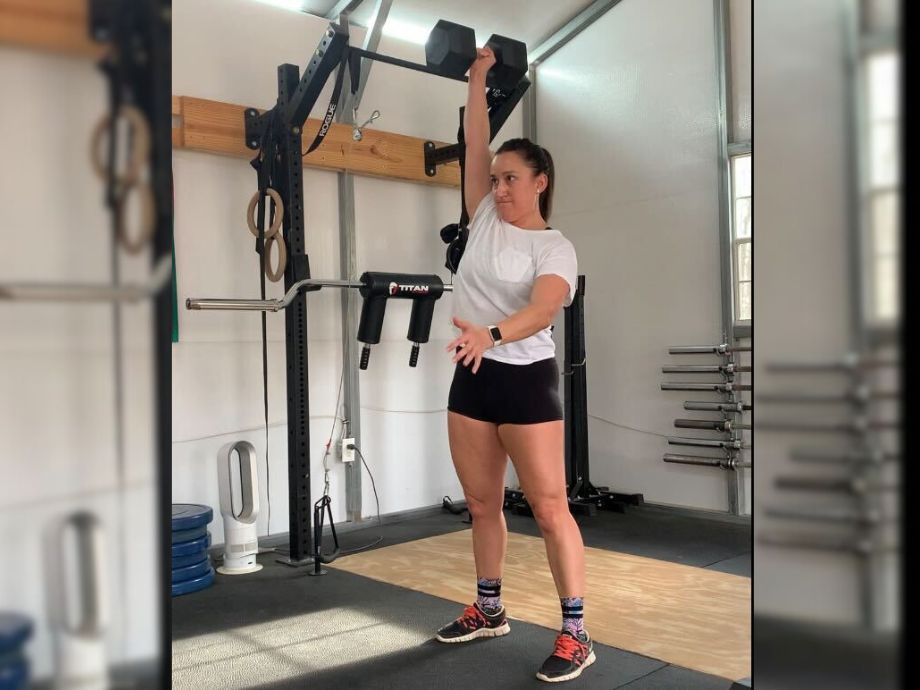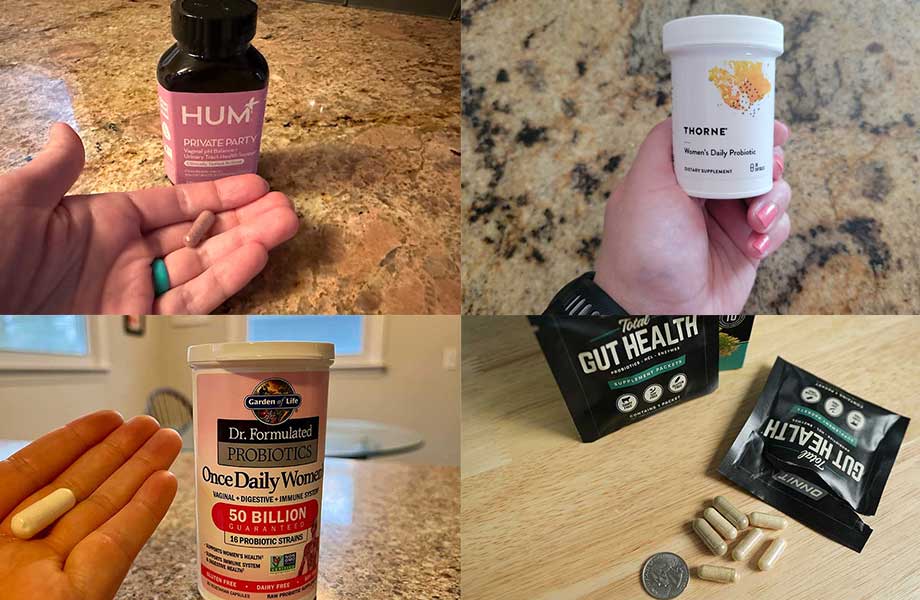If you’re like me, chest day is the most important day of the training week. There’s a reason why it’s done on a Monday in gyms across the world (hats off to you if you usually do leg day on a Monday!).
The inner chest, although it doesn’t get a lot of attention, can make all of the difference to how your chest looks and how your body moves. Why, you ask? Because the shape and striations you get with a developed inner chest can make the whole chest look bigger and more complete. A strong inner chest also makes vertical and lateral movements easier to do.
Although genetics play a huge part, there are exercises that can help you target the inner chest to increase strength and muscle mass. I’ll explain my nine favorite exercises and how to do each one, then give tips so you can get the most out of your inner chest workout. I’ll also go through the anatomy of the chest muscle groups.
RELATED: Dumbbell Chest Workout
Are you ready to sculpt the inner chest you’ve always dreamed of? If yes, then let’s get straight into the best inner chest exercises for you to try.
Medical disclaimer: This article is intended for educational and informational purposes only. It is not intended as a substitute for medical advice. For health advice, contact a licensed healthcare provider.
9 Best Inner Chest Exercises
These are the best inner chest exercises for hypertrophy—or, in other words, these moves are how to build inner chest muscles with minimal equipment.
- Weighted Push-Up
- Dumbbell Bench Press
- Incline Dumbbell Bench Press
- High-to-Low Cable Fly
- Close Grip Bench Press
- Incline Bench Press
- Hex Press
- Dumbbell Pullover
- Pinch Plate Press
Equipment Needed
- Weight Plate
- Dumbbell
- Barbell and weight plates
- Weight Bench
- Cable machine or functional trainer
1. Weighted Push-Up
Why Do It: Push-ups are a bodyweight exercise that not only works the inner chest, but also the rest of the chest, deltoids, triceps, and more. There are tons of variations you can do with push-ups, too, which is why I like them—for example, diamond push-ups or wide-hands push-ups.
How to Do It:
- Get into the plank position with your hands slightly wider than shoulder-width apart.
- Before you start the exercise, put a weight plate on your upper back. Alternatively, you can use a weighted vest for this.
- Engage your core and glutes, then lower your body toward the ground by bending your elbows. Keep your back straight and your neck neutral.
- When you’re as close to the ground as possible, pause, then slowly push up to the starting position (until your arms are straight).
- That’s one rep. Continue for the desired number of reps.
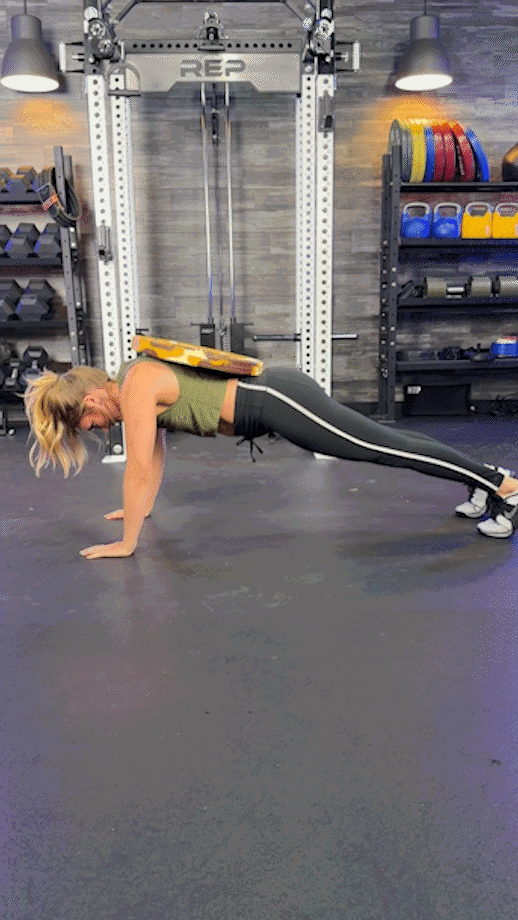
2. Dumbbell Bench Press
Why Do It: The dumbbell bench press is a staple in the bodybuilding world for good reason. Regularly doing this exercise can work your pectoralis major and pectoralis minor, as well as other muscles in your upper body. Because it’s a unilateral movement (you lift one dumbbell with each hand), it can also help to fix muscle imbalances.
How to Do It:
- On a flat bench, sit down with the dumbbells placed on your quadriceps.
- Lie down. Position the dumbbells so that they’re by your chest on the outside of your body (with your palms facing away from you).
- Retract your shoulder blades and stick your chest up to get the most out of this chest press movement.
- Press both dumbbells toward the ceiling until your arms are straight.
- Pause at the top, then bring the dumbbells back to their original position.
- Repeat for reps, then come off the bench in the reverse order.
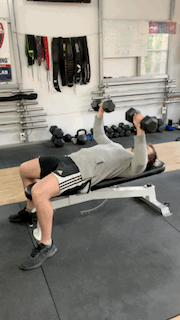
3. Incline Dumbbell Bench Press
Why Do It: Similar to the dumbbell bench press, the incline version is a great exercise for inner chest development. You’ll work your chest, shoulders, triceps, core, and more. Not only this, but the incline dumbbell bench press can strengthen the stabilizer muscles around your shoulder joints.
How to Do It:
- Set the bench so that it’s at a 30- to 45-degree angle.
- Lie down with the dumbbells outside of your body near the chest region. Your feet should be flat on the floor.
- Breathe in to engage your core, then press the dumbbells up until your elbows are locked out. The weights should be over your body.
- Hold for a second, then lower the dumbbells back down.
- Repeat for the desired number of reps.
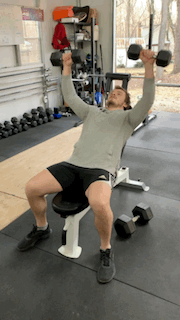
4. High-to-Low Cable Fly
Why Do It: Flyes are an excellent addition to any workout plan for the inner chest, and I particularly like the cable chest fly over the dumbbell fly because it’s a bit easier on the joints. When compared to dumbbell or barbell chest presses, you may engage more muscle fibers in the stretched position during this exercise.
RELATED: Best Cable Machine for Home Gyms
How to Do It:
- On a cable crossover machine, set the pulleys so that they’re as high as possible.
- Attach handles to both sides and pick the desired weight.
- Take hold of the handles with a neutral grip and step forward a few steps (your arms should be open here and you should feel a stretch in your pecs).
- With a slight bend in your elbows, push the handles forward until they meet in front of your body.
- Bring the handles back to the starting position on the cable machine.
- Continue for the desired number of repetitions.
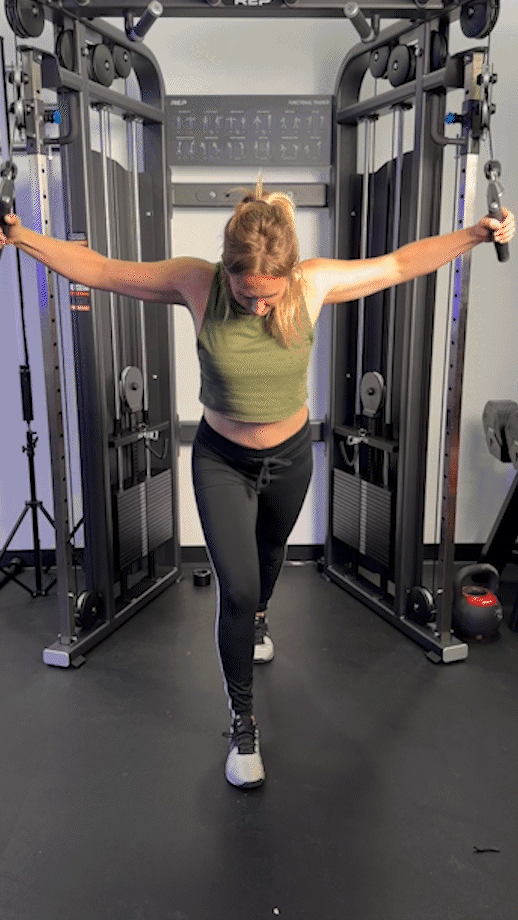
5. Close Grip Bench Press
Why Do It: The bench press is a compound exercise that can build muscle in the chest, triceps, and anterior deltoid. It’s the king (or queen!) of chest exercises. The close-grip version, when compared to the regular grip, can reduce the stress on the shoulders because of the way you hold the bar. It can help to prevent your elbows from flaring.
How to Do It:
- Lie down on a flat bench with the bar parallel to your eyes and your feet on the floor.
- Take hold of the barbell firmly, with your hands slightly less than shoulder-width apart (narrower than you would do a conventional bench press but not too narrow, as this will result in more activation in the triceps).
- Bring your shoulder blades together and engage your core to activate the inner chest muscles.
- Now, take the bar off the rack and hold it in the position at the top.
- Slowly lower it down to your chest, then push it back up to the starting position.
- Repeat for the recommended number of reps.
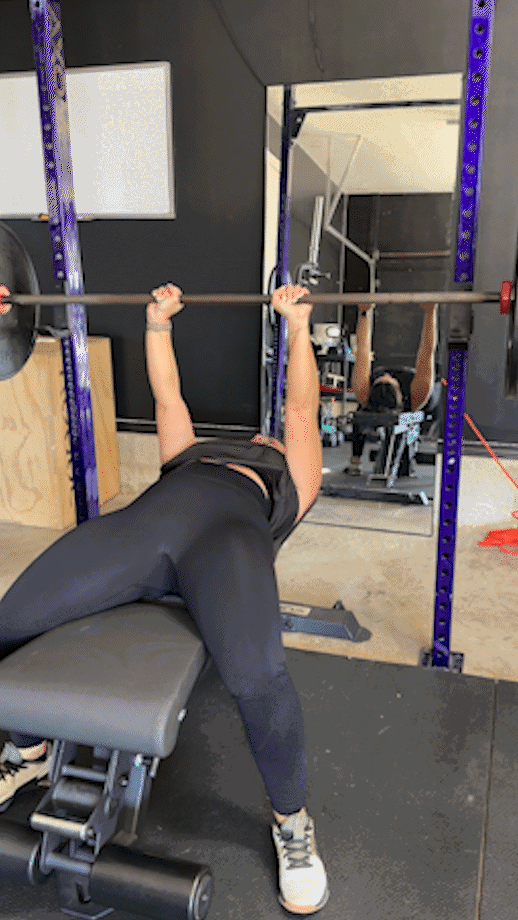
6. Incline Bench Press
Why Do It: An inner chest workout routine wouldn’t be complete without the incline bench press. One of the main advantages of doing the incline version is that you have a slightly longer range of motion during the exercise, which may result in more muscle growth and strength.
RELATED: Best Weight Bench
How to Do It:
- Start by lying down on an incline bench with your feet flat on the floor.
- Grab a barbell firmly with both hands (slightly wider than shoulder-width apart).
- Take the bar off the rack and hold over your chest.
- Lower it down to your upper chest region, then push it back up. You’ll want your pectoral muscles to stay engaged throughout the whole movement.
- Continue for reps, then re-rack the barbell.
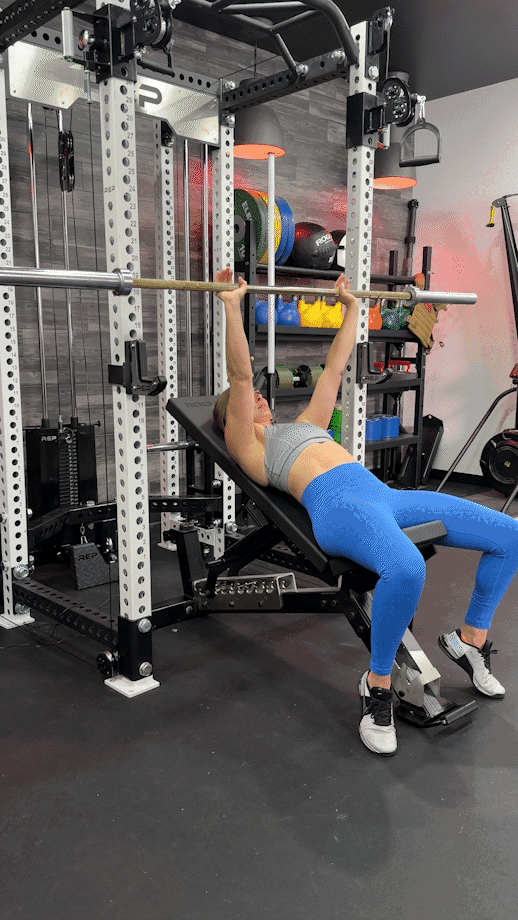
7. Hex Press
Why Do It: The hex press may activate the inner chest muscles slightly more than regular chest presses. Because you use a neutral grip during the movement, there’s less stress on the shoulder joints so the hex press (also known as the squeeze press) can be a good exercise for those with shoulder injuries or limited shoulder mobility.
How to Do It:
- Sit down on a flat or incline bench with two dumbbells resting on your quads.
- Lie down on your back. Extend the dumbbells above your body so that they’re touching each other (with your palms facing each other).
- With the dumbbells touching at all times, bend your elbows so that the dumbbells slowly move toward your chest.
- Pause when they touch your chest, then return the dumbbells to their original position.
- Repeat for reps.
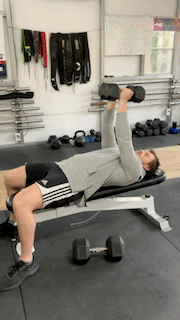
8. Dumbbell Pullover
Why Do It: The dumbbell pullover works the majority of muscles in the upper body, including the chest, lats, serratus anterior, triceps, and more. You’ll also strengthen the glutes and core during this exercise. It can also help to improve your posture.
How to Do It:
- Place your shoulders and upper back on a flat bench (you can also do this lying fully on the bench).
- Engage your glutes and core, and make sure that your knees are at a 90-degree angle.
- Take hold of a dumbbell by placing both hands underneath one end in a triangular shape (with your palms facing the ceiling).
- Extend your arms so that they’re above your chest.
- Lower your arms until the dumbbell is behind your head (a slight bend in the elbows helps with this).
- Slowly bring the dumbbell back to the starting position.
- Keep going for the desired number of repetitions.
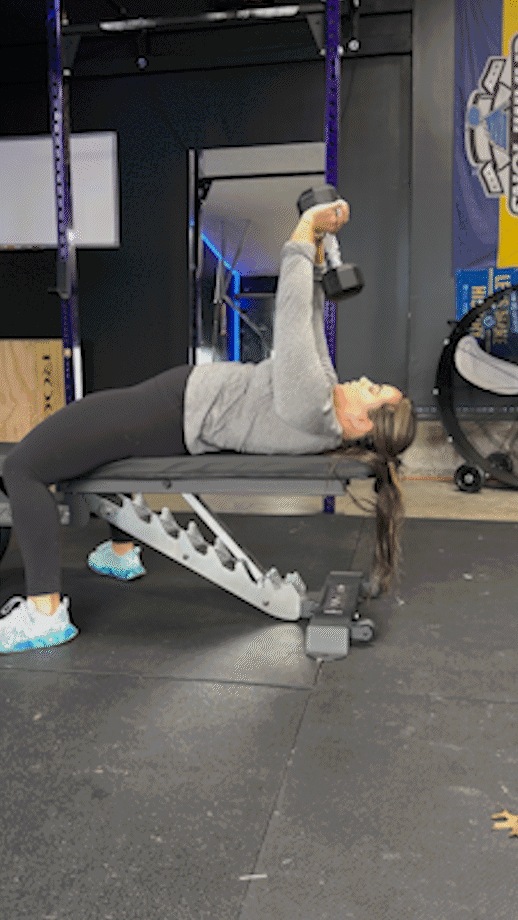
9. Pinch Plate Press
Why Do It: The pinch plate press works the upper and lower chest muscles. Because it’s an isolation movement, you’ll focus primarily on the chest muscles and not other muscle groups. You don’t need much equipment to do it either (a couple of weight plates will do).
How to Do It:
- Squeeze a weight plate between both hands (your hands should be open and your palms should be facing each other).
- Lay back on a bench with the weight plate held over your chest.
- Move the plate so it’s touching the middle of your chest. This will be your starting position.
- Extend your arms forward and upward to push the plate out. Pause.
- Slowly bring the plate back to your chest, ensuring that your elbows stay close to your body.
- This is one rep. Continue for the desired number.
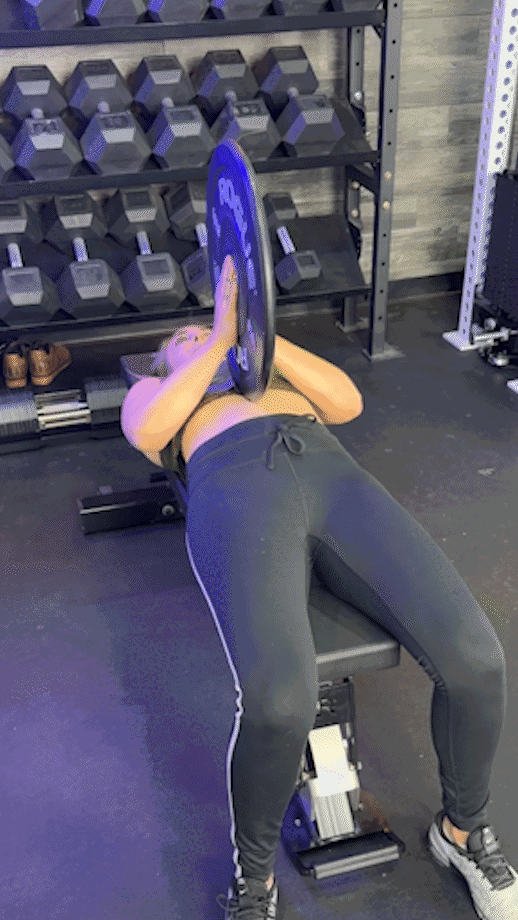
Anatomy of Chest Muscle Groups
The chest or pectoral muscles are made up of four different muscles, including:
- Pectoralis major
- Pectoralis minor
- Serratus anterior
- Subclavius
The pectoralis major is the largest. It’s thick, fan-shaped, and allows for flexion of the humerus1. In contrast, the pectoralis minor is thinner and sits below the pectoralis major. It’s crucial for stabilizing the scapula. The serratus anterior is a thin muscular sheet that helps to pull the scapula forward around the thorax (for example, when you throw a punch). And last but not least, the subclavius is a small triangular muscle that helps to depress the shoulder as well as elevate the first rib.

What Is the Inner Chest?
So, how does the inner chest fit into all of this?
Without complicating things too much, there’s more to it. The pectoralis major is made up of two heads—the sternocostal head and the clavicular head. The sternocostal head is known as the lower chest and the clavicular head is known as the upper chest. Both attach and end at the humerus.
The inner chest lies within the sternocostal head, close to the middle. It’s not a separate muscle that you can train by itself, but rather, you work the inner chest by doing chest exercises for the sternocostal head (and to some extent, the clavicular head, too!). That being said, while most chest exercises will work the inner chest to some extent, the nine exercises above are what I’ve found to be the most effective.
Tips For Training the Inner Chest
Now that you know my nine favorite inner chest exercises, as well as exactly what the inner chest is, here some tips for you to get the most out of your inner chest workout:
Rep Range
It’s worth having a variety of rep ranges in your inner chest workout to maximize your results. Personally, I like to aim for between 5 and 8 reps on compound exercises because this allows me to lift heavier weights (sometimes, I’ll even do 3 reps). Then, when switching to isolation exercises, I go for between 8 and 12 reps in order to get hypertrophy benefits.
Grip
With the close grip bench press and the incline bench press, the positioning of your hands on the barbell matters. While both of these exercises are usually done with your hands slightly wider than shoulder-width apart, here, I’d recommend a slightly narrower grip to work your inner chest (and ultimately triceps!) more. Just don’t go too narrow. It’s likely that you’ll have to reduce the weight for this.
One of the reasons why the hex press and plate pinch press were chosen for this inner chest workout is because they use a neutral grip which is easier on the shoulder joints compared to other exercises. Choose these exercises if you find others uncomfortable to do.
Mind-Muscle Connection
When training the chest especially, we want to lift heavy weights. I get it. Who doesn’t want to tell their friends that they can bench press three plates on either side? However, this may come at the detriment of the mind-muscle connection, which is when you feel and focus on the muscle group you’re working (the inner chest in this case). Contracting the target muscle during training and the mind-muscle connection can lead to enhanced muscle hypertrophy2.
Lift heavy weights but don’t ego lift—the mind-muscle connection is more important.
Barbell vs Dumbbell
Some say barbells are better for inner chest activation. Others say dumbbells are. I’m happy to sit on the fence on this one. From my experience, both are great. I find that I can lift heavier weights with a barbell, but with dumbbells, I can isolate the inner chest better. You also get the benefit of having an increased range of motion during certain exercises. It shouldn’t be one or the other, but in fact, your inner chest workout should have a combination of the two.
RELATED: Best Adjustable Dumbbells
Benefits of Training the Inner Chest
Besides giving you a Chris Evans-esque physique, middle chest exercises can help you get stronger, especially when it comes to pressing movements.
Inner Chest Workout: Final Thoughts
Regularly doing an inner chest workout may make all the difference between a decent-looking chest and a chest that makes you look like a Greek god. Genetics play a big role, but with hard work, you may be able to sculpt the inner chest you’ve always wanted.
To review, here are my nine favorite inner chest exercises for you to try:
- Weighted Push-Up
- Dumbbell Bench Press
- Incline Dumbbell Bench Press
- High-To-Low Cable Fly
- Close Grip Bench Press
- Incline Bench Press
- Hex Press
- Dumbbell Pullover
- Plate Pinch Press
Inner Chest Workout: Q&A
How do you work your inner chest?
The best inner chest workout involves some or all of the following exercises: weighted push-up, dumbbell bench press, incline dumbbell bench press, high-to-low cable fly, close grip bench press, incline bench press, hex press, dumbbell pullover, and pinch plate press. It’s worth experimenting with these exercises to see what works your inner pecs in the most effective way.
Can you get rid of inner chest gap?
The gap in your inner chest, otherwise known as the sternum, is usually caused by two main reasons. The first is genetics, and the second is because your chest muscles aren’t big enough yet. You can’t change your genetics, of course, but you may find that training your chest with inner chest exercises can make your inner chest gap less noticeable (or not noticeable at all!).
How do you target your inner upper chest?
If you’re looking to target the inner upper chest, try the incline dumbbell bench press and the incline bench press. Although other exercises for the chest also work the inner upper chest muscles, a 30 to 45-degree incline on the bench can help to increase muscle activation in the upper pecs3. That’s exactly the angle I recommend with both of these exercises.
How can I build my inner chest without equipment?
Any variety of push-ups are a great way to develop your inner chest without equipment.
References
- Baig MA, Bordoni B. Anatomy, Shoulder and Upper Limb, Pectoral Muscles. [Updated 2022 Aug 30]. In: StatPearls [Internet]. Treasure Island (FL): StatPearls Publishing; 2023 Jan-. Available from: https://www.ncbi.nlm.nih.gov/books/NBK545241/
- Schoenfeld BJ, Vigotsky A, Contreras B, Golden S, Alto A, Larson R, Winkelman N, Paoli A. Differential effects of attentional focus strategies during long-term resistance training. Eur J Sport Sci. 2018 Jun;18(5):705-712. doi: 10.1080/17461391.2018.1447020. Epub 2018 Mar 13. PMID: 29533715.
- Lauver JD, Cayot TE, Scheuermann BW. Influence of bench angle on upper extremity muscular activation during bench press exercise. Eur J Sport Sci. 2016;16(3):309-16. doi: 10.1080/17461391.2015.1022605. Epub 2015 Mar 23. PMID: 25799093.


